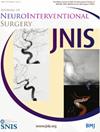Radiomic profiling of high-risk aneurysms with blebs: an exploratory study
IF 4.5
1区 医学
Q1 NEUROIMAGING
引用次数: 0
Abstract
Background Blebs significantly increase rupture risk of intracranial aneurysms. Radiomic analysis offers a robust characterization of the aneurysm wall. However, the unique radiomic profile of various compartments, including blebs, remains unexplored. Likewise, the correlation between these imaging markers and fluid/mechanical metrics is yet to be investigated. To address this, we analyzed the radiomic features (RFs) of bleb-containing aneurysms and their relationship with wall tension and shear stress metrics, aiming to enhance risk assessment. Methods Aneurysms were imaged using high-resolution magnetic resonance imaging (MRI). A T1 and a T1 after contrast (T1+Gd) sequences were acquired. 3D models of aneurysm bodies and blebs were generated, and RFs were extracted. Aneurysms with and without blebs were matched based on location and size for analysis. Univariate regression models and Spearman’s correlations were used to establish associations between bleb-dependent RFs and mechanical/fluid dynamics metrics. Results Eighteen aneurysms with blebs were identified. Fifty-five RFs were significantly different between blebs and body within the same aneurysms. Of these RFs, 9% (5/55) were first-order, and 91% (50/55) were second-order features. After aneurysms with and without blebs were matched for location and size, five RFs 5% (5/93) were significantly different. Forty-one out of the 55 RFs different between bleb and body sac of the primary aneurysm were moderately and strongly correlated with mechanical and fluid dynamics metrics. Conclusion Aneurysm blebs exhibit distinct radiomic profiles compared with the main body of the aneurysm sac. The variability in bleb wall characteristics may arise from differing mechanical stresses and localized hemodynamics. Leveraging radiomic profiling could help identify regions with a heightened risk of rupture. All data relevant to the study are included in the article or uploaded as supplementary information.带有出血点的高风险动脉瘤的放射线组学分析:一项探索性研究
背景 动脉瘤出血会大大增加颅内动脉瘤破裂的风险。放射学分析可提供动脉瘤壁的可靠特征。然而,包括出血点在内的各种区段的独特放射学特征仍有待探索。同样,这些成像标记与流体/机械指标之间的相关性也有待研究。为此,我们分析了含血栓动脉瘤的放射学特征(RF)及其与动脉瘤壁张力和剪应力指标的关系,旨在加强风险评估。方法 使用高分辨率磁共振成像(MRI)对动脉瘤进行成像。采集了 T1 和造影后 T1(T1+Gd)序列。生成动脉瘤体和瘤栓的三维模型,并提取射频。根据位置和大小对有出血点和无出血点的动脉瘤进行匹配分析。使用单变量回归模型和斯皮尔曼相关性来确定栓带依赖性射频和机械/流体动力学指标之间的关联。结果 确定了 18 个有出血点的动脉瘤。在同一动脉瘤中,出血点和瘤体之间有 55 个 RFs 显著不同。在这些射频中,9%(5/55)为一阶特征,91%(50/55)为二阶特征。对有出血点和无出血点的动脉瘤进行位置和大小匹配后,5%(5/93)的 RFs 存在显著差异。在原发性动脉瘤瘤栓和瘤体囊之间不同的 55 个 RFs 中,有 41 个与机械和流体动力学指标呈中度和高度相关。结论 与动脉瘤囊主体相比,动脉瘤栓泡表现出不同的放射学特征。瘤栓壁特征的变化可能源于不同的机械应力和局部血流动力学。利用放射轮廓分析有助于确定破裂风险较高的区域。与该研究相关的所有数据都包含在文章中或作为补充信息上传。
本文章由计算机程序翻译,如有差异,请以英文原文为准。
求助全文
约1分钟内获得全文
求助全文
来源期刊

Journal of NeuroInterventional Surgery
NEUROIMAGING-SURGERY
CiteScore
9.50
自引率
14.60%
发文量
291
审稿时长
4-8 weeks
期刊介绍:
The Journal of NeuroInterventional Surgery (JNIS) is a leading peer review journal for scientific research and literature pertaining to the field of neurointerventional surgery. The journal launch follows growing professional interest in neurointerventional techniques for the treatment of a range of neurological and vascular problems including stroke, aneurysms, brain tumors, and spinal compression.The journal is owned by SNIS and is also the official journal of the Interventional Chapter of the Australian and New Zealand Society of Neuroradiology (ANZSNR), the Canadian Interventional Neuro Group, the Hong Kong Neurological Society (HKNS) and the Neuroradiological Society of Taiwan.
 求助内容:
求助内容: 应助结果提醒方式:
应助结果提醒方式:


